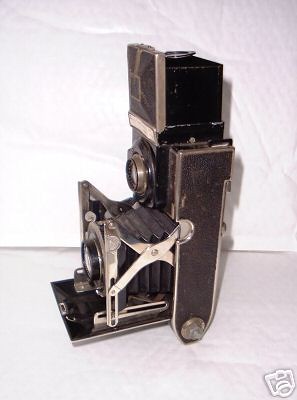Zeca-Flex

|
| Zeca Flex folding TLR Photo by ebayer 6469davidh (Image rights) |
The Zeca-Flex is a 6×6 folding TLR, made in Germany by Zeh in the mid-1930s (some sources state 1935 and others state 1937). It is extremely unusual in that it combines both the body of a folding camera with a twin-lens reflex viewing system fitted to one end of the body. This camera along with the Welta Superfekta and Perfekta are likely the only folding TLR cameras ever made. The Welta cameras are more similar to a standard TLR camera in that the viewing and taking lenses are mounted to the same board.
The Zeca-Flex has a complex focusing system in which the taking lens is fitted to a moving board while the viewing lens is fitted to the reflex housing. The viewing lens has a shorter focal length than the taking lens, allowing for a smaller reflex housing and less distance between the axes of the taking and viewing lenses, thus reducing parallax error. However, this difference in focal lengths adds to the complexity of the focusing system, in which each lens moves independently in degrees proportional to their respective focal lengths.
There were various taking lenses offered, including Schneider Xenar or Radionar 75mm f/3.5, or Zeiss Tessar 75mm f/3.5, paired with either Compur or Compur Rapid shutters. The viewing lens appears to always be a Sucher-Anastigmat f2.9[1]. The camera takes 12 exposures on 120 film.
Folding TLRs were more complex, and not much smaller than non-folding TLRs - and were not popular. Consequently, these cameras were only on the market for a very short period of time, and are today quite rare.
Features:
- Compur or Compur Rapid shutter
- Film counter device
- Hinged Back
- Magnifier
- Hinged film cradle to simplify loading of film
An eveready case was offered as an accessory.

|
| closed Photo by ebayer 6469davidh (Image rights) |
Notes
Links
- German Patent 633672, Photographische Ausziehkamera mit Einstellsucher (Photographic pull-out camera with focusing viewfinder), filed February 193 and granted August 1936 to Ernst Zeh; at Espacenet, the patent search facility of the European Patent Office.
- Zeca-Flex on UKCamera.com (English & German) (archived)
- Zeca-Flex on Novacon.com.br
- Zeca-Flex on 120folder.com
- Zeca-Flex on CameraClassics (archived)